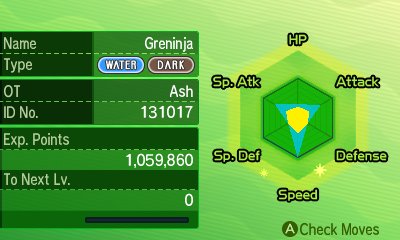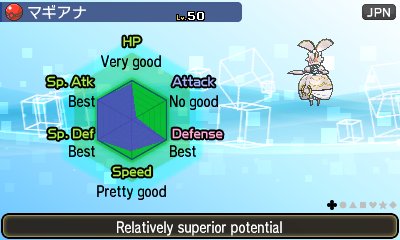Effort Values (EVs)
Effort Values, or EVs for short, are points that increase each of your Pokemon's stats, like Attack, Defence, HP, etc. Along with base stats, natures, IVs and level, EVs are used to calculate the stats you see in your Pokemon's summary screen.
Each Pokemon can have a maximum of 252 EVs in each stat, and a maximum of 510 EVs in total. How much this actually affects its stats depends on its level — see note 3 below for more info. Otherwise, just remember that at level 100, 4 EVs will contribute one stat point to your Pokemon's total.
This means that a level 100 Pokemon can get up to 63 extra points in a given stat, and up to 127 in total, from EVs. (You can find this by calculating 252/4 and 510/4 respectively.) Pokemon keep all their EVs when they level up, so it doesn't matter what level the Pokemon gained its EVs at.

The stats graph in Gen 7. This Greninja has EVs in Attack, Sp Atk and Speed. It has max 252 Speed EVs, which makes the stat glitter. It also has max 510 total EVs, which makes the EV graph turn blue. credit: Serebii
Your Pokemon gain EVs mainly by defeating other Pokemon in battle; each species has an EV yield that dictates how many EVs it will hand out when it is KO'd, and in which stats. For example, defeating Pikachu will yield 2 Speed EVs for all Pokemon that fought against it.
With careful planning, you can control how many EVs your Pokemon gets, and in which stats (EV training). You can use this to strategically allocate EVs, creating the best advantage for your Pokemon. This is a key component of moveset building in competitive play.
The common 252 / 252 / 4 EV spread is created when people choose to fully max EVs in two stats, and leave the last four meaningful points in another stat. In almost all cases, EV spreads based around 252 / 252 / 4 are good and are recommended to newbies as a starting point. This article on Smogon introduces the strategy of EVs in competitive play.
If you have an in-game team, then the EVs on the Pokemon in your team are likely spread out everywhere from the enemies they've fought during the story. Obviously, this isn't strategically optimal.
EVs have evolved over the generations. Here are some relevant points:
- In Gen 1 and 2, EVs use a totally different system, where the optimal strategy is to just max everything.
- Until Gen 6, the maximum number of EVs per stat was 255 (though this doesn't affect strategies with level 100s, since 4 is not a factor of 255).
- In Gen 7 onwards, it is possible to view a chart of your Pokemon's EVs by pressing a button in its summary screen.
- The timing and frequency of stat recalculation (and thus when new EVs are "applied") varies by game. Stats are always recalculated upon level up, but in more recent games, any change in EVs also leads to an immediate recalculation of your Pokemon's stats.
Your Pokemon can get extra EVs for defeating Pokemon using Power items, Macho Brace and Pokerus. You can manually boost EVs in a particular stat using Vitamins and Feathers. The main way to decrease EVs is by feeding your Pokemon EV-reducing berries.
Individual Values (IVs)
Individual Values, or IVs for short, are random numbers assigned to your Pokemon in each stat. Like EVs, IVs contribute to your Pokemon's stat total, but they are much harder to manipulate, especially in older games. You may think of IVs as your Pokemon's genes.
Each of your Pokemon's stats has an IV ranging from 0 to 31. Your Pokemon's IVs in all stats are generated using pseudo-RNG when you first encounter them — for Eggs, this means when you first pick them up. Like EVs, the effect of IVs on your Pokemon's stats scales with its level; at level 100, one IV is worth one real stat point. This means that at level 100, IVs can add as many as 31 points to each stat, and 186 in total.

A screenshot of the IV judge in Gen 7. The graph gives an approximation of Magearna's IVs in each stat. "Best" indicates perfect 31 points, while "No good" indicates 0 points. credit: Serebii
In most cases, it is ideal to have Pokemon with six stats fully-maxed with 31 IVs, colloquially referred to as 6 IV Pokemon. When sharing movesets, it is assumed the Pokemon has six perfect IVs unless otherwise stated, which is why you often don't see IVs mentioned in movesets shared online (or you might only see "IVs: 0 Atk", which is an optimisation to reduce self-confusion damage).
IVs are random and difficult to track, making 6 IV Pokemon hard to come by for the average player; and until Gen 7, it was totally impossible to 'fix' imperfect IVs on your Pokemon. This was obviously a bother to the competitive community, so the developers have gradually made IVs easier to access and control, especially through breeding.
In Gen 6+, items like the Destiny Knot and Power items can help you breed high IVs onto Egg Pokemon, and features like the Poke Radar, SOS chaining and Max/Tera Raid Battles help you encounter high-IV Pokemon. In older Pokemon games without such convenient game mechanics, players use RNG manipulation to get Pokemon with good IVs.
IVs have also changed over the generations. Here are some relevant events in the timeline:
- Since Gen 3, there has been a stats judge (i.e. an NPC) in the game who will say some vague information about your Pokemon's IVs.
- Since Gen 4, every Pokemon has been given a characteristic on its summary screen, which indicates what stat its highest IV lies in.
- Since Gen 6, event Pokemon and static encounters have had three guaranteed perfect IVs.
- Since Gen 7, it has been possible to view a graph of your Pokemon's IVs using the PC. Gen 7 also introduced Super Training, which lets you artificially boost your Pokemon's stats up to perfection using Bottle Caps (though it does not increase the actual IV).
Like EVs, IVs took a different form in Gen 1 and 2. In these old games, IVs ranged from 0 to 15, and the HP IV was generated using the Pokemon's other IVs. Furthermore, IVs were used to determine traits like gender and Shininess; this functionality has been progressively transferred to a different system called personality values (which most people can happily ignore).
Notes
1: The main series games have used the term 'base stats' to mean EVs. This term is rejected by fans, who still say 'EVs'. Fans instead use the term 'base stats' to mean the species-bound stat points (e.g. Bulbasaur's Attack base stat is 49).
2: Here are formulas that you can use to calculate the "real" stat points you see on your Pokemon's summary screen.
3: The number of EVs your Pokemon requires to gain one "real" stat point is equal to 400/level (more info). Example: 400/100 = 4 for level 100 Pokemon. You can easily infer this using the stat calculation formula above. However, this calculation is subject to rounding. Especially at low levels and levels that are not factors of 400, the breakpoints for real stat gains are driven by other factors. This is relevant for formats like Little Cup; read more here. One consequence of this is that level 1 Pokemon can sometimes increase their stats using EVs, even though 400/1 = 400.